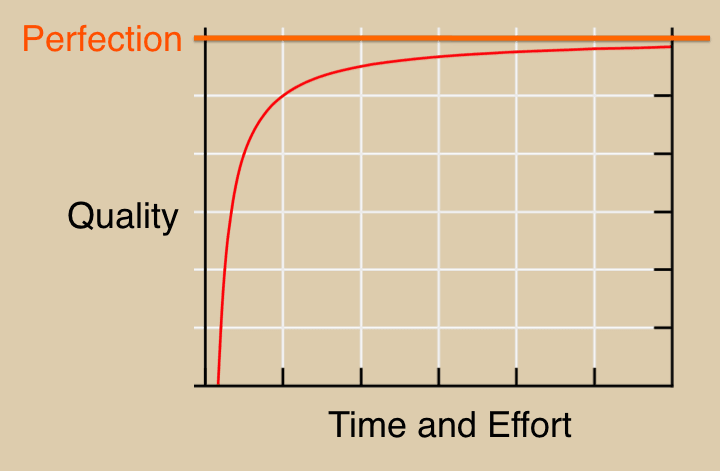Recently, I wrote a post entitled Basic Speech Geometry. Today we return to the mathematics of points and lines and curves and surfaces.
An asymptote is a straight line that a curve approaches but never touches. It comes from the Greek word asymptotos which means “not falling together”. In the diagram below, the horizontal orange line (“Perfection) is an asymptote to the curved red line.

Think of it this way: You are standing in a field. To your left, a straight wall extends infinitely in the direction you are facing. You begin walking. With every step forward, you move slightly to the left, reducing the distance between you and the wall by 1% each time. As you walk, you will get closer and closer to the wall without ever reaching it.
So, what does all this have to do with public speaking? Well, perfect public speaking is an asymptote. Nobody has ever reached it and nobody ever will. There is always room for improvement. There is always room to learn.
Even the most famous speeches in history have not been perfect. If you watch and listen carefully to Martin Luther King’s “I Have a Dream” speech, you will see that even the great Dr. King himself stumbled over a word here and there. Indeed — and many people do not realize this — Dr. King changed abandoned the prepared text in the middle of his speech because he believed he was not connecting enough with the audience. Thus were born the now immortal words on the theme of “I have a dream”.
No, Martin Luther King’s speeches were not perfect all the time. Nor were Abraham Lincoln’s or Winston Churchill’s or Nelson Mandela’s or Gandhi’s. And yet … they were brilliant, poignant, inspirational and life-changing.
One of the reasons that great speakers are great is because the speakers themselves realize that they are not perfect. They know that there is always room to improve. They understand that they must learn from past mistakes and build upon past successes in order to become better speakers. And therein lies the challenge for all of us.
We might never be perfect speakers, but we can be better speakers. We can even be great speakers. It all depends on how badly we want it, and on how willing we are to work at it. So practice. Video yourself. Get good feedback. Watch great speeches. Read books and blogs on public speaking and presentation skills. And don’t be discouraged by occasional setbacks. They are bound to happen.
We will never touch that wall stretching off into infinity, but we might just surprise ourselves by how close we get to it.
Update
I have to acknowledge my public speaking colleague, Richard Garber. He writes a great blog, Joyful Public Speaking, which I invite you to check out.
In a recent post, Richard took the time to comment in detail about about this post. He noted that although the image I used when I wrote this post is an asymptote, it does not convey the point as well as the image above (which I have pinched from his blog).
Richard took the time to create an image that supported my idea much more effectively. He also referred to that great quote by Mark Twain — “The difference between the almost right word and the right word is really a large matter — it’s the difference between the lightning bug and the lightning.” — and noted that the same thing could be said about images.
Point well taken, Richard. Thanks!
















10 Replies to “Perfect Public Speaking is an Asymptote”
Great visual, John! Thanks for the nod to “no one is ever perfect”. Post presentation I have made it a habit to conduct my own debrief. What worked and what didn’t.
Last week while presenting to students I realized that in my best intentions of sharing “all” they needed to know to be able to go out and fly with strong wings, I was overwhelming them. I had to restructure my presentation on the fly and it was a tad rough. Lesson learned – as always it is all about audience, not my best intentions.
Thank you John. Well said.
Hi Janice. Thanks very much. Glad you enjoyed the post … and the visual! (Big kudos to Creative Commons for the latter.) And congrats on being able to change direction in the middle of your presentation. Not an easy thing to do. However, the most important thing, as you said, is what you learned from the experience. It will doubtless be helpful in the future.
John:
Great concept, but I think the graphic misses the mark. Have a look at my edited version at:
http://joyfulpublicspeaking.blogspot.com/2011/02/effort-and-asymptote.html
Richard, thanks so much for taking the time to prepare an article on the importance of getting the right image. I have left a comment on your blog and have gone ahead and used your (much better) image this post. I’ve also added an update to the post to draw readers’ attention to the important point you make.
Thanks again.
John
John: Of course you are welcome to use that image. After all, it was derived from Wikimedia Commons. In making it I was influenced by Dave Paradi’s slide makover podcasts.